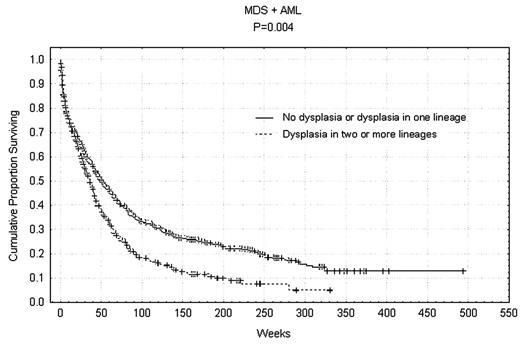Abstract
Acute myeloid leukemia (AML) and the myelodysplastic syndromes (MDS) comprise a heterogeneous group of hematopoietic neoplasms. The World Health Organization (WHO) classification includes the two new categories: AML with dysplasia in more than one lineage (multilineage dysplasia; MLD) and refractory cytopenia with MLD. However, the relevance of dysplasia in one lineage versus more than one lineage and the importance of separating MDS with MLD from AML with MLD are not known. We studied 1110 patients with AML and 171 patients with MDS classified according to the WHO criteria and treated at MD Anderson Cancer Center from 1995 to 2003. All MDS patients had advanced disease requiring treatment and included 19 patients with refractory anemia (RA), 7 with RA with ringed sideroblasts (RARS), and 145 with RA with excess blasts (RAEB). Survival analysis showed no statistical significance in overall survival between MDS patients and AML patients when classified according to the WHO classification (P=0.196). When AML and MDS patients were considered as one group, but divided based on the presence or absence of MLD, patients with MLD had significantly shorter survival (P=.004; Figure 1). More importantly, multivariate Cox proportional hazard model showed that the shorter survival in the combined AML and MDS patients with MLD was independent of cytogenetic abnormalities, antecedent hematologic disease, performance status, and the original diagnosis of AML or MDS. As expected, shorter survival was found in AML patients with MLD as compared with those with no dysplasia or dysplasia of one lineage (P=.003). The presence of dysplasia in one lineage was irrelevant for the clinical course. Apoptosis detection using annexin V staining or mitochondrial membrane potential analysis showed significantly higher apoptosis in AML patients with MLD as compared with those patients without MLD and the presence of increased apoptosis correlated with shorter survival (P=.04). The present study demonstrates that the criteria established by the WHO classification for the diagnosis of AML and MDS can be significantly enhanced if the presence or absence of MLD is considered irrespective of the percentage of blasts. Furthermore, apoptosis can be detected in AML and MDS patients using annexin V staining or mitochondrial membrane potential analysis and it can be utilized to indirectly reflect the level of dysplasia in these patients. With the progress in targeted therapy, the classification of leukemia and myelodysplasia based on biological abnormalities may provide more helpful clues for therapy and clinical management.
Author notes
Corresponding author


